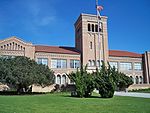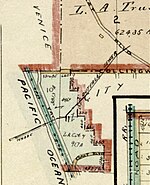Recreation Park (El Segundo)
El Segundo, CaliforniaGeography of Los AngelesLos Angeles County, California geography stubsParks in Los Angeles County, California

Recreation Park. is a public, urban park in El Segundo, California, a suburb of Los Angeles. Located adjacent to Downtown El Segundo, Recreation Park is bordered by Pine Street on the North, Eucalyptus Drive on the West, and houses on the South and East.
Excerpt from the Wikipedia article Recreation Park (El Segundo) (License: CC BY-SA 3.0, Authors, Images).Recreation Park (El Segundo)
Eucalyptus Drive,
Geographical coordinates (GPS) Address Nearby Places Show on map
Geographical coordinates (GPS)
| Latitude | Longitude |
|---|---|
| N 33.9211 ° | E -118.4124 ° |
Address
Eucalyptus Drive
90245
California, United States
Open on Google Maps







